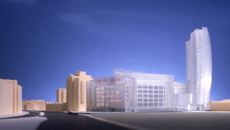Private competitions: Anamorphosis of profitability
by Jacques Lachapelle
, published 2007-01-01

The winning project of Quadrangle and Peter Pran for the competition on the Tip Top Tailors site proposed a deformed curvilinear tower that followed Deconstructivist trends. If this competition was reduced to the simple design of an iconic tower to stand out in the urban landscape, it would be of little interest. This however is not the case.
Launched in 1994, this competition was one of the rare to be initiated by a private company, Dylex Ltd. In the competition outline, the Professional Consultants, Urban Strategies Inc., highlighted the site's wealth of qualities. It was located both at the edge of the Harbourfront - the old port of Toronto successfully redeveloped, and Corona Park in the hip neighbourhood of Garrison Common. Finally, the property itself included the Tip Top Tailors factory, an Art Deco style building recognized for its historical value.
A port and landscape site offering views of the city as well as Lake Ontario, the range of possible sources of inspiration was very extensive. Of the five participants, only Dan Hanganu insisted on a lower volume in order to structure his proposal in response to the existing building. Justifying forms and designs by axes, views, and site opportunities, all the other competitors chose to add a tower in contrast, at times, with the historical building, itself left on its own. The change of attitude is clear: historicism, for some, is a thing of the past.
This process gained popularity amongst developers, who stepped off the beaten path and took advantage of the competition formula. Yet, the winning project was not constructed as Dylex Ltd. was unable to follow through. A single case does not form a rule. Other examples are needed in order to determine whether the competition formula is profitable for the private sector. The CCC includes another such example, the Absolute Design Ideas Competition which also took place in Toronto. The winning team, MAD Office, proposed an elegant deformed tower which, in addition to the Tip Top Tailors case, could incite irony on the anamorphosis which is the current outlet of real estate profitability in urban centres. The attentive comparison of these two competitions reassures us of the serendipity of analyses and solutions proposed by architects.
Launched in 1994, this competition was one of the rare to be initiated by a private company, Dylex Ltd. In the competition outline, the Professional Consultants, Urban Strategies Inc., highlighted the site's wealth of qualities. It was located both at the edge of the Harbourfront - the old port of Toronto successfully redeveloped, and Corona Park in the hip neighbourhood of Garrison Common. Finally, the property itself included the Tip Top Tailors factory, an Art Deco style building recognized for its historical value.
A port and landscape site offering views of the city as well as Lake Ontario, the range of possible sources of inspiration was very extensive. Of the five participants, only Dan Hanganu insisted on a lower volume in order to structure his proposal in response to the existing building. Justifying forms and designs by axes, views, and site opportunities, all the other competitors chose to add a tower in contrast, at times, with the historical building, itself left on its own. The change of attitude is clear: historicism, for some, is a thing of the past.
This process gained popularity amongst developers, who stepped off the beaten path and took advantage of the competition formula. Yet, the winning project was not constructed as Dylex Ltd. was unable to follow through. A single case does not form a rule. Other examples are needed in order to determine whether the competition formula is profitable for the private sector. The CCC includes another such example, the Absolute Design Ideas Competition which also took place in Toronto. The winning team, MAD Office, proposed an elegant deformed tower which, in addition to the Tip Top Tailors case, could incite irony on the anamorphosis which is the current outlet of real estate profitability in urban centres. The attentive comparison of these two competitions reassures us of the serendipity of analyses and solutions proposed by architects.














